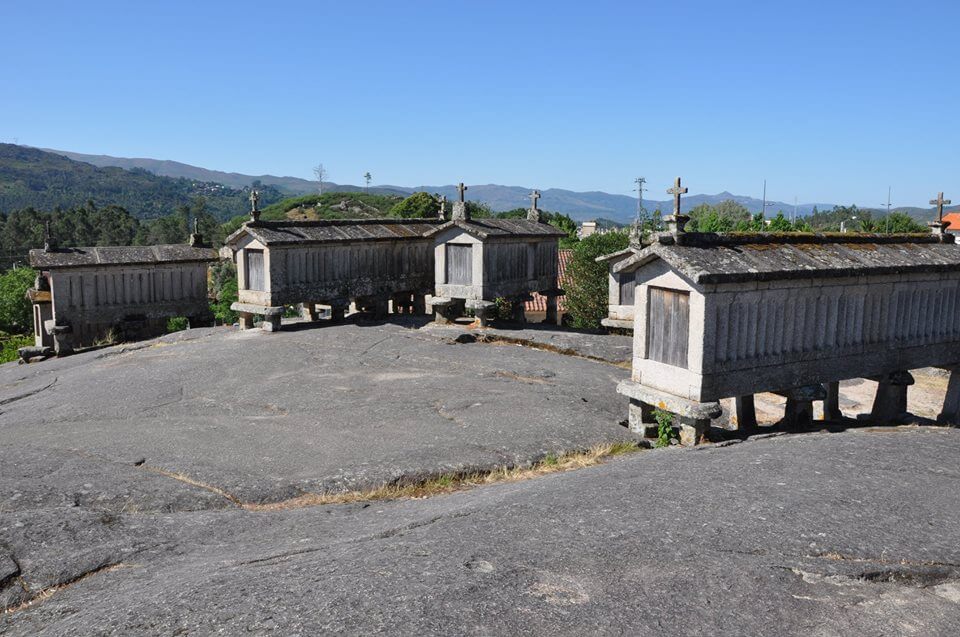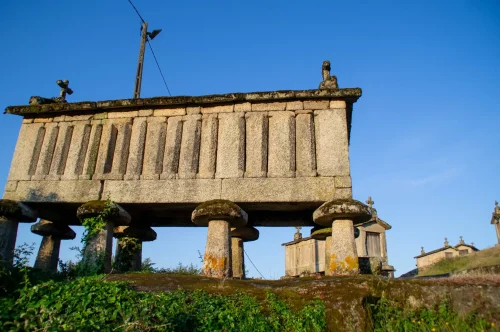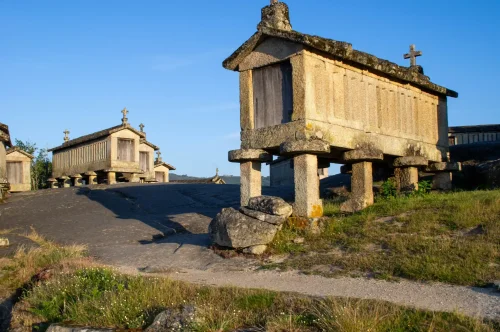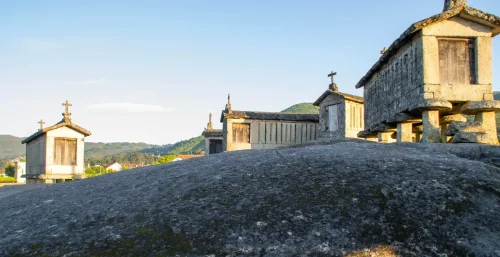Soajo granaries
Learn more about the granaries of Soajo.
Granaries
The granaries or espigueiros are iconic and emblematic structures of the Portuguese rural landscape. Found in various regions of the country, these traditional constructions have played a vital role in preserving cereals over the centuries. With their peculiar architecture and profound cultural significance, the espigueiros are living witnesses of Portugal's agricultural history.
Originating from ancient times, espigueiros are elevated structures built with wood, stone, or granite, usually supported by stone pillars or stakes. Their characteristic shape consists of a rectangular or square base, with walls made of wooden slats and a gabled roof. This peculiar configuration allows for proper ventilation, which is essential for drying and preserving cereals, especially corn.
These structures are not limited to cereal storage; they also carry symbols and cultural traditions. Espigueiros were used as communal spaces where local farmers would share agricultural techniques and knowledge, as well as celebrate festivities and rituals related to the agricultural cycle.
The geographical distribution of espigueiros is extensive in Portugal, being particularly common in the northern part of the country, where they constitute an essential part of the rural landscape. Regions such as Minho, Trás-os-Montes, and Alto Douro are known for housing a significant number of these traditional structures, some of which date back centuries.
Today, espigueiros continue to play an important role in Portuguese culture. They are considered symbols of local identity and attract tourists and history enthusiasts who wish to explore the richness of the country's rural heritage. Furthermore, many espigueiros are carefully preserved, demonstrating the dedication to keeping this unique tradition alive.
In summary, espigueiros represent an essential part of Portugal's agricultural and cultural legacy. With their unique architecture and historical significance, these structures continue to enchant and preserve the memory of rural communities, highlighting the importance of the past and the richness of tradition in the present.
The Soajo granaries or espigueiros
The largest concentration of granaries in Gerês
Soajo granaries
The Espigueiros of Soajo, located in the picturesque village of Soajo, in the Peneda-Gerês National Park, are one of the most remarkable and impressive examples of traditional Portuguese architecture. These unique structures hold significant historical, cultural, and aesthetic importance, and are considered one of the main points of interest in the region.
These structures are built with carefully fitted stones, without the use of mortar, showcasing the skill and knowledge of the ancient local craftsmen. The roofs are made of stone slabs arranged in a scale-like pattern, creating a resilient and long-lasting covering. Each espigueiro has a small wooden door, which provides access to the interior and facilitates the placement and removal of cereals.
The Espigueiros of Soajo have a history that dates back centuries. It is believed that they were built in the 18th century, but the tradition of storing cereals in elevated structures is much older, possibly dating back to Celtic times. Originally, these espigueiros were used to store corn, which was a staple food in the region and a vital agricultural crop for the sustenance of local communities.
The Espigueiros do Soajo are a set of 24 granite granaries, arranged in two parallel rows, forming a kind of “street” of granaries. Each one is approximately two meters high and is supported by four stone pillars, which create an empty space under the granary. This specific architectural feature serves two main purposes: protecting the grain stored inside and allowing air circulation for proper drying.
In addition to their practical function as cereal storage units, the Espigueiros of Soajo also played an important social role in the community. They served as meeting places where farmers shared knowledge, exchanged experiences, and strengthened community bonds. Moreover, these structures were also used in festivities and rituals related to the agricultural cycle, such as the celebration of the "Senhor do Mundo," a popular festival that takes place every year on the first Sunday of July.
The preservation of the Espigueiros of Soajo over the centuries is remarkable. Despite natural wear and the elements, they remain virtually unchanged, silent witnesses of local history and culture. The community of Soajo has a deep respect and attachment to these structures, and conservation measures have been taken to ensure their preservation. The ensemble of Espigueiros of Soajo has been classified as a National Monument since 1983, and continuous efforts are made to maintain their integrity and authenticity.
Espigueiros of Soajo nowadays
Nowadays, the Espigueiros of Soajo are a renowned tourist attraction, attracting visitors from different parts of the world. Tourists are fascinated by the beauty and uniqueness of these structures, as well as the rich history they represent. While walking along the "street" of espigueiros, visitors can admire up close the traditional architecture, appreciate the intricate details of the stone construction, and imagine the lives of the agricultural communities that depended on these structures.
In addition to visiting the espigueiros themselves, the village of Soajo offers a charming atmosphere with narrow cobblestone streets, granite houses, and a preserved rural environment. Visitors can also explore the stunning landscapes of the Peneda-Gerês National Park, with its mountains, streams, and scenic trails, providing a complete and immersive experience.
The Espigueiros of Soajo are more than just architectural structures; they are a symbol of the identity and history of a community. They represent the richness of Portuguese cultural heritage and the importance of preserving ancestral traditions. These unique structures, which have withstood the test of time, serve as a tangible reminder of the deep connection between humans and the land, the significance of agriculture in people's lives, and the legacy left by past generations.
In summary, the Espigueiros of Soajo are a cultural treasure of Portugal, whose beauty and significance transcend time. They are a testament to the skill and creativity of local artisans, the importance of community, and the preservation of traditions. When visiting these structures, travelers have the opportunity to delve into history, appreciate the traditional architecture, and understand the importance of these espigueiros in Portuguese culture.
The Soajo granaries or espigueiros
Our gallery
View all the photos of the Espigueiros of Soajo.
The visit to the Espigueiros of Soajo in video.
Experience Soajo
A journey into the culture and nature of the National Park Peneda-Gerês.
We await your contact
(Call to portuguese national mobile network)









